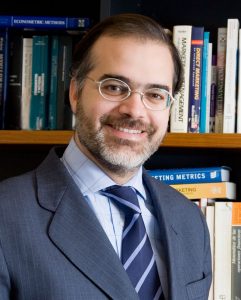Interview with Prof. Julián Villanueva (IESE Business School)
Interview with Prof. Julián Villanueva (IESE Business School)

Prof. Julián Villanueva (IESE Buiness School)
Prof. Julian Villanueva is the Head of the Marketing Department at IESE Business School. He holds a Ph.D. in Management (Marketing) from UCLA, an MBA at IESE, and a B.A. in Economics (Universidad Complutense de Madrid).
Member of the Scientific Committee of CBIM2018 International Conference
His interests fall in the area of digital marketing, customer equity (or customer lifetime value), branding and salesforce management, among others. His research has been published in the Journal of Marketing Research, Journal of Marketing and Quantitative Marketing and Economics, among others. Prof. Villanueva is also the author of several books, managerial articles and more than 50 case studies and technical notes. Two of his cases are in the Harvard Business School Premier Case Collection.
He regularly teaches MBAs and executives at IESE, and has also taught at CEIBS (China), Nile University (Egypt), INALDE (Colombia), IPADE (Mexico), IAE (Argentina), IDE (Ecuador), PAD (Perú), IEE (Costa Rica) and IEEM (Uruguay).
Julián, can you please tell us about your main areas of research?
I am working on how marketing actions produce long-term results. I have tackled these issues mainly through econometric modeling approaches.
You are an expert in digital marketing, what are the challenges to digital transformation?
In my opinion there are three main challenges. First, understanding how the customer is changing because of the new technologies that will shape the future of an industry. Second, ensuring the “digital commitment” from the board. Third, executing the change.
Your article “The impact of marketing-induced versus word-of-mouth customer acquisition on customer equity growth” published in the Journal of Marketing Research has attracted a lot of interest. Which are the main findings and conclusions?
In my opinion this was one of the first –if not the first- digital attribution models published in a Marketing Journal, and its main use was to provide a model capable of measuring the long-term effect of different acquisition channels. We found WOM to be much more valuable than marketing-induced channels.
What message do you have for young researchers on marketing?
Work on topics that are interesting to them and that are novel. Talk to managers to understand what is interesting to them. Find top researchers that are interested in the same problems and work with them. Specialize in one methodology at first and become a master of it.
As you know, as member of the Scientific Committee of CBIM2018, the theme of the International Conference is “Sustainable business models: integrating employees, customers and technology”. How relevant it is that employees, customers and technology can be integrated into the marketing strategies of companies? How can it be implemented effectively?
Very relevant. We will see in future years a revolution of job destruction and job creation in many sectors, because of technology. Technology will substitute many people, but will also empower other people to become more effective or to do things that were impossible before. Hence, the relationship of employees with customers will change dramatically.